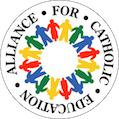ENL 15 on the 15th: Dual Language Schools

This month’s 15 on 15th spotlights an innovative school model – Dual Language Catholic schools or Two-Way Immersion (TWI) Catholic schools. We invite you to take 15 minutes to learn more about this model, which manifests deep mutual respect for linguistic and cultural diversity. This model has shown evidence of cognitive, social, emotional, and economic benefits (Gándara, 2015).
Dual Language Catholic schools are grounded in an educational approach that recognizes language and culture as assets to instruction and learning. In this model, native English speakers and speakers of another language (traditionally Spanish speakers) learn side-by-side, and content and literacy is taught in both languages. The most common models are 90/10 (students learn literacy sequentially in one language and then the other) and 50/50 (students learn literacy simultaneously in two languages). The ultimate goal is bilingualism, biliteracy, and biculturalism, the sharing of faith traditions, and solidarity in Gospel witness.
There is much excitement surrounding the growth of Dual Language Catholic schools in the United States. We’ve collected several resources to help you learn more about how these schools work and why Catholic schools are so well positioned to implement the model so effectively.
Finally, consider completing a survey to help us learn more about Dual Language schools in your area.
What Research Says
- In this article by Collier and Thomas (2004), the authors describe the “astounding” effects of two-way immersion for all learners, as well as the closure of the achievement gap for English language learners.
- This set of guiding principles from the Center for Applied Linguistics is divided into seven strands which include topics such as assessment and accountability, curriculum, instruction, and program structure among others.
- In a review of research, Howard, Sugarman, and Christian (2003), describe ways of measuring literacy and language outcomes.
Why Dual Language Works Well in Catholic Schools
- Fraga (2016) explores the promise and potential of Two-Way Immersion in Catholic Schools. Fraga suggests that the model can build “intercultural communities grounded in Catholic faith” (p. 141).
- Scanlon and Zehrbach (2010) make the case that a “two-way immersion approach to bilingual service delivery is philosophically and functionally well suited for Catholic schooling” (p. 67).
- In this article, the principal of the school stated, “We've had a lot of newcomer students come to us because it is a safe place where they can learn, but also where their culture, their language, is valued.” Read more about the school’s transition and about the Two-Way Immersion Network for Catholic Schools: http://www.twin-cs.org/
School Spotlights



